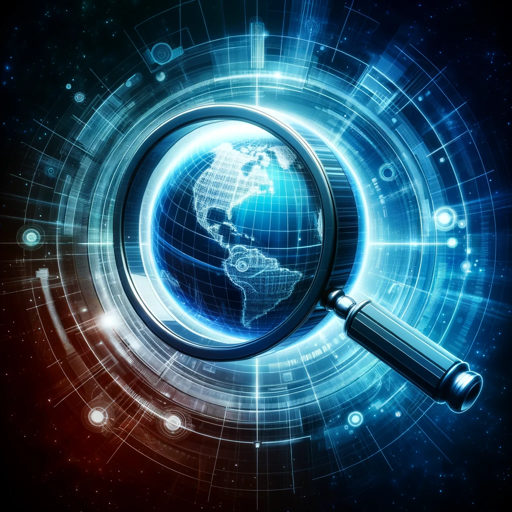Plant GPT-AI-Powered Plant Identification
AI-Powered Botany for Everyone
🌱 I'm your AI botanist, ready to identify plants from images and answer your greenery questions! 🌿
What is the plant in the image?
How often should I water this plant?
Can this plant thrive in cold weather?
What is the wikipedia page of the plant?
Related Tools
Load More
GPT Finder
Discover the best Custom GPT at OpenAI's GPT Finder

GPT Finder 🔍
GPT Finder 🔍 is a search tool designed for efficiently finding the best custom GPTs from a selection of over 133,000 GPTs. It initially checks a specialized database and then utilizes Google search if necessary, ensuring that users find the best match amo

GPT-Builders' Assistant
Effortless GPT Creation : Your Go-To Assistant for Tailoring Perfect Descriptions, Instructions, and Behaviors for Custom GPTs

GPT Builder
User-friendly assistant for creating GPTs.

GPT Builder V2.4 (by GB)
Craft and refine GPTs. Join our Reddit community: https://www.reddit.com/r/GPTreview/

Correct English GPT
Write English like a native speaker. Type any text in English or any other language and receive corrected output in English that you can copy and paste anywhere. To improve the style of the corrected text, send "s"
20.0 / 5 (200 votes)
Introduction to Plant GPT
Plant GPT is a specialized AI designed to assist users with a wide range of botanical needs. This includes plant identification, care instructions, information on habitat and distribution, and more. Leveraging a comprehensive database of global plant species, Plant GPT offers detailed insights for professionals, hobbyists, and anyone with an interest in plants. For example, if a user encounters an unfamiliar plant during a hike, Plant GPT can accurately identify it from a photo and provide information on its characteristics, natural habitat, and any potential toxicity. Similarly, a gardener can inquire about the best care practices for a specific plant, receiving tailored advice on watering, sunlight, soil type, and pest management.

Main Functions of Plant GPT
Plant Identification
Example
A user uploads a photo of a flowering plant they found in their backyard.
Scenario
Plant GPT analyzes the image, identifies the plant as a 'Rudbeckia hirta' (Black-eyed Susan), and provides detailed information about its growing conditions, bloom period, and any common pests or diseases it may encounter.
Care Instructions
Example
A user wants to know how to care for their newly acquired 'Monstera deliciosa'.
Scenario
Plant GPT offers specific care guidelines, including optimal light conditions, watering frequency, preferred soil type, and tips on promoting healthy growth, ensuring the user can maintain the plant effectively.
Habitat and Distribution Information
Example
A researcher is studying the native habitats of 'Quercus robur' (English Oak).
Scenario
Plant GPT provides comprehensive data on the distribution of the species across Europe, its role in local ecosystems, and the environmental conditions it requires, aiding the researcher in their study.
Ideal Users of Plant GPT
Botany Enthusiasts and Hobbyists
This group includes individuals who have a passion for plants, whether they are home gardeners, amateur botanists, or simply nature lovers. They benefit from Plant GPT's detailed plant care guides, identification tools, and insights into plant biology, helping them deepen their understanding and care for their plants more effectively.
Professionals in Horticulture and Botany
This group consists of professionals such as horticulturists, botanists, and landscape architects who require accurate and detailed plant information for their work. Plant GPT supports these users by offering precise identification, data on plant distribution, and advanced care recommendations, assisting them in research, project planning, and fieldwork.

How to Use Plant GPT
1
Visit aichatonline.org for a free trial without login, also no need for ChatGPT Plus.
2
Ensure you have a clear description or image of the plant you wish to identify. This will optimize the accuracy of Plant GPT's identification capabilities.
3
Ask specific questions or provide detailed descriptions to receive tailored information about plant care, identification, or comparison.
4
Use Plant GPT to explore related plants, learn about their habitats, or understand their ecological roles. This can be especially useful for research or educational purposes.
5
Utilize the tool’s capability to provide warnings on toxic plants or highlight endangered species, ensuring safe handling and conservation efforts.
Try other advanced and practical GPTs
FlutterFlow Copilot
AI-powered guide for FlutterFlow development

Web Search!
AI-powered search for detailed insights

Course Creator Pro
Create courses effortlessly with AI.

Status Report
AI-powered monitoring for OpenAI services.

MixerBox FindGPT
AI-Powered GPT Search Made Easy

Slides Presentation Creator
AI-powered presentations made easy.

Leonardo AI Prompt Maker
Unlock creativity with AI-driven prompts.

Translator
AI-powered translations for seamless communication.

WebPilot GPT
AI-powered tool for web data extraction and content generation

Presentation Slides
AI-powered tool for professional presentations
Video to Text
AI-powered Video Transcription Simplified

Web Search
AI-Powered Search for Instant Insights

- Plant Identification
- Botanical Research
- Gardening Advice
- Toxic Plants
- Species Comparison
Detailed Q&A About Plant GPT
How accurate is Plant GPT in identifying plants from descriptions or images?
Plant GPT is highly accurate, leveraging a comprehensive botanical database and advanced AI algorithms to identify plants with precision. The accuracy is maximized when clear, detailed descriptions or high-quality images are provided.
Can Plant GPT provide care instructions for a specific plant species?
Yes, Plant GPT offers detailed care instructions tailored to specific plant species, including ideal soil conditions, watering needs, sunlight requirements, and common pests or diseases to watch for.
Is Plant GPT able to differentiate between similar-looking plant species?
Absolutely. Plant GPT can distinguish between closely related or similar-looking species by highlighting key differences in leaf shape, flower color, growth patterns, and other botanical characteristics.
Can I use Plant GPT for academic research or environmental studies?
Yes, Plant GPT is an excellent tool for academic research and environmental studies, providing in-depth information on plant species, their ecological roles, distribution, and conservation status.
Does Plant GPT provide information on the toxicity of plants?
Yes, Plant GPT includes warnings about the toxicity of plants, helping users avoid harmful species. It also provides guidelines on safe handling and information on symptoms in case of exposure.